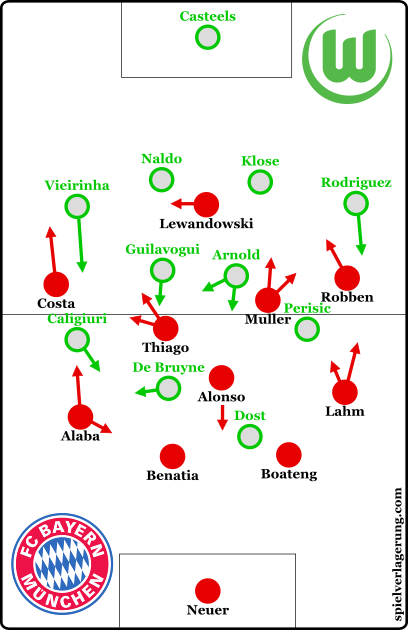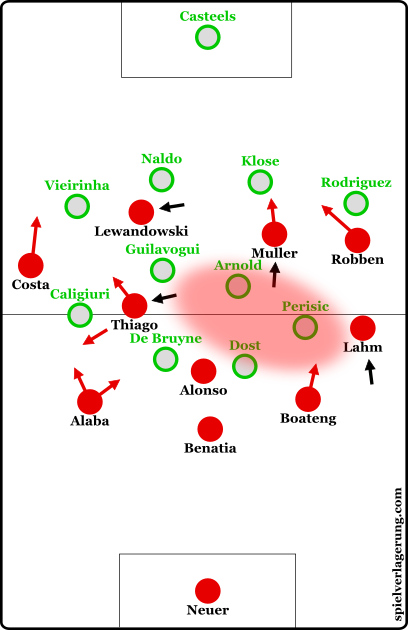Super Cup: Wolfsburg – Bayern 1:1 (5:4 Penalties)
Despite leading for the majority of the second half after Robben opened the scoring, Guardiola is still without a Super Cup victory for Bayern as Wolfsburg stole a victory on penalties after Niklas Bendtner equalised late on.

The initial formations
Guardiola made somewhat of a surprise selection, fielding what was a 4-1-4-1 without the ball becoming a 3-2-4-1 (amongst other numbers) in possession. Alaba and Lahm took the positions of full-backs though Alaba in particular acted as a half-back for periods of the game. Douglas Costa got his first competitive start for Bayern on the left wing and demonstrated an incredible explosiveness in his pace whilst somewhat surprisingly, Thomas Muller started as the right 8 alongside Thiago.
Hecking on the other hand fielded a shape with little change to how they presented themselves throughout the last campaign. De Bruyne was in his usual position behind Bas Dost up front. The system was generally a 4-2-3-1 shape whilst it became a 4-4-2 later on with the introduction of Niklas Bendtner.
Bayern’s Asymmetrical Build-Up Shape

Bayern’s Lopsided Build-Up Shape
For the first 45 minutes, Bayern fielded an asymmetrical shape during their early possession. From the initial 4-1-4-1 shape, Alaba stayed deep in a 3-chain whilst Lahm pushed higher up into the midfield line.
On the left half of the pitch, both Thiago and Lewandowski shifted towards the touchline to aid in connections and potential overloads which positionally supported Costa on a few occasions as the Brazilian created a number of 1v1 opportunities early on. Down the right side, Lahm stayed wide (until Guardiola changed around the 15th minute) in a midfield line with Muller more vertically oriented than Thiago and Robben in a direct role higher up.
Between the flanks sat an at-times alone Alonso who struggled to build connections through the team and his poor positioning hurt the overall structure of the team.
In reaction, Hecking’s side pressed in a lopsided 4-3-3 shape as Caligiuri moved higher on Alaba with Perisic deeper against the advanced Lahm. Initially the outcome was poor, as Alaba started well and Bayern prospered to some degree down their left. However as Wolfsburg grew into the game, they slowly became on top due with improved pressing and defensive control.
Bayern’s shape was particularly wing-oriented with a lack of presence centrally which, despite causing issues for Wolfsburg for the opening stages of the game, proved an issue for Guardiola’s team as it developed and the Wolves improved. Early on Wolfsburg struggled to deal with Bayern’s developments down the left as Costa was able to create 1v1s with the support from Lewandowski who occupied Naldo whilst Thiago and Alaba created a foundation deeper.
However once Wolfsburg improved and closed out these spaces much better, Bayern’s possession game struggled without any presence in the middle of the pitch as their focus was to the wings. Changes from Guardiola fixed this issue somewhat but still they could never develop a dominance over the Wolves whose newly-found stability proved key. During wide possession Bayern failed to utilise diagonal passing to circulate the ball into more threatening areas and the ball instead became isolated out wide.
Bayern Against the Ball
Without the ball Bayern were structured in a much more ‘standard’ 4-1-4-1 though that itself had some interesting variations in the pressing during Wolfsburg’s early possession. The Bavarian pressing caused issues for Hecking’s side who often resorted to long balls towards Dost as apposed to directly challenging the press of Lewandowski and co.
Lewandowski would situationally receive support from the ball-near central midfielder who would push up and help direct the ball towards the wing to create trap opportunities whilst Alonso and the ball-far CM would also move up slightly to maintain good spatial compactness within the 10 space. Another variation was where the ball-far winger would push up alongside Lewandowski to the opposite centre-back in order to restrict potential switches by Lewandowski’s centre-back under pressure.
Wolfsburg Early Issues and Improvements
Hecking’s side were second best during the opening stages of the match as they had some issues in their defensive organisation. During Bayern’s wide possession they struggled to close out the spaces on the wings which resulted in Douglas Costa threatening throughout the opening 20 minutes. On the left they often struggled to press Alaba and suffered from a lack of access as the Austrian could push up with multiple passing options both vertically and diagonally.
As the game progressed, Wolfsburg improved their pressing with greater ball-orientation whilst they closed the passing lanes into midfield much more effectively. Their compactness in the 4-4-1-1 increased which only served to emphasise Bayern’s lack of presence through the middle and connections across the structure. In Bayern’s early possession there became a period where they played long diagonal passes towards Costa and Robben (primarily the former) and despite Boateng’s excellent distribution it was ineffective as even if the pass was completed, the duration of the pass was enough for Wolfsburg to prepare for a strong press on the touchline. With more long passing on show, the short combinations in smaller scenes became more and more rare as Bayern lacked the connections to execute such patterns despite Pep’s best attempts to amend these issues.
Changes from Pep
Throughout the game, Pep made numerous subtle changes either to the shape as a whole or smaller switches involving the orientation and movements of individuals or small groups of players.
Guardiola shifted from the lesser orthodox build-up shape from the first 45 minutes to a more standard one which was much more symmetrical. The change was mainly in the full-backs as Alaba started to make more forward movements as apposed to the deeper role he previously possessed whilst Lahm came slightly deeper on the opposite side of the pitch. As the game progressed, the German right-back also became more oriented towards the half-space though this was a change initially without relation to the building shape.
Around the 15th minute mark, Lahm began to move inside towards the centre of the pitch instead of the wide positioning which he had adopted at the start of the game. Throughout Bayern’s early possession it seemed like Pep wasn’t satisfied with their progression down the right side of the field as they had some key issues in the connections and spacing. Their shape in possession often left massive gaps within the centre of the pitch which wasn’t helped by the presence of Alonso whilst Lahm was out on the touchline providing little support in his team’s possession game. In order to amend this issue, Guardiola moved Lahm towards a more central position in the right half-space and by doing this looked to improve the connections through the centre and simply filling the gap. In turn the previously isolated Thiago on the left was supported by a central presence which was lacking beforehand.
Another change throughout the games was the movements and orientation of both Muller and Robben. As the game progressed, the former adopted more of a horizontally-based role whilst Robben started becoming inside. In addition, the two made a straight rotation frequently during different stages of the game.
The reason for Muller’s change in orientation is likely the movement of Lahm as is the process of spacing in juego de posicion – there can be a max of 2 players on the same vertical line. Having just 2 players on the same vertical line is not always optimal either as it reduces the ability for diagonal passing whilst it is much easier for the defence to control through the use of basic cover shadows. Additionally, the raumdeuter made balancing movements for the inside orientation of Robben. Whilst both the Dutch winger and Lahm came inside, Muller was often on the touchline to maintain the width and balance in the structure.
Aside from the positional features of these changes, Muller’s movement opened central passing lanes to Lewandowski which Boateng could utilise at times with his laser passing. Otherwise Bayern struggled somewhat to develop direct central access so this situationally provided an effective means of finding Lewandowski through vertical passing.
Although these in-game changes had some positive result, they weren’t enough to fix the deficiencies in Bayern’s system and for the majority of the game they lacked the connections to develop an effective possession game. This may have been the inspiration for introducing Vidal late on aside from the obligatory new signing appearance however the impact was not as desired.
3 Kommentare Alle anzeigen
Handyortung September 2, 2015 um 8:12 am
Bayern had the better of the game, but Wolfsburg wasted some of the better chances before earning a late lifeline and then completing a hat trick of Super Cup defeats for Bayern coach Pep Guardiola.
Saad August 5, 2015 um 2:23 am
Excellent analysis, as always.
Just a remark :
We’ve already seen Guardiola trying to force 4v4 against the opponent’s defense (in his time with Barça), playing with 3 offensive players (two on the sides and one in the axis) and having one of his midfielders (8s) occasionnally going up field “locking” an additional defender after being sure the prior build up lower on the field was viable.
In the shape showed in the second picture, we can easily note that will, accentuated with Muller being in the beginning 11 as a “midfielder”, which he isn’t actually. The strong side of this strategy is that it promotes 1v1s between your attackers and the opposite defenders, which you usually want when you think your attackers’ can beat their straight opponent by being “more talented”.
The problem stays that the build up from the back is made harder : Wolfsburg, locking the axis with its 4-4-2 shape (pretty usual shape) almost eliminates Xabi Alonso’s impact on the game/build up (which could be huge thanks to his passing ability, which might have enabled Bayern to access more often to the 1v1 situations I’ve been talking about).
This wouldn’t have been that much of a problem if the 1v1 abilities of Wolfsburg’s defense wasn’t that good, maybe better than Guardiola may’ve imagined, which might be the reason why he chose this tactic that seemed innefficient versus the wolves. Only Vierihinia was weaker 1v1 (versus D. Costa) which has led to a goal for Bayern, but it just wasn’t enough to defeat a team that (in my opinion) won thanks to it’s strong individualities “defense side”.
What do you think ? (Sorry for the english that may not be perfect)
Thank you so much for your great work by the way !!
dex-footballmatter August 4, 2015 um 11:27 am
Nice and analytical…my question is why Guardiola do not trying to open fast positive transition play